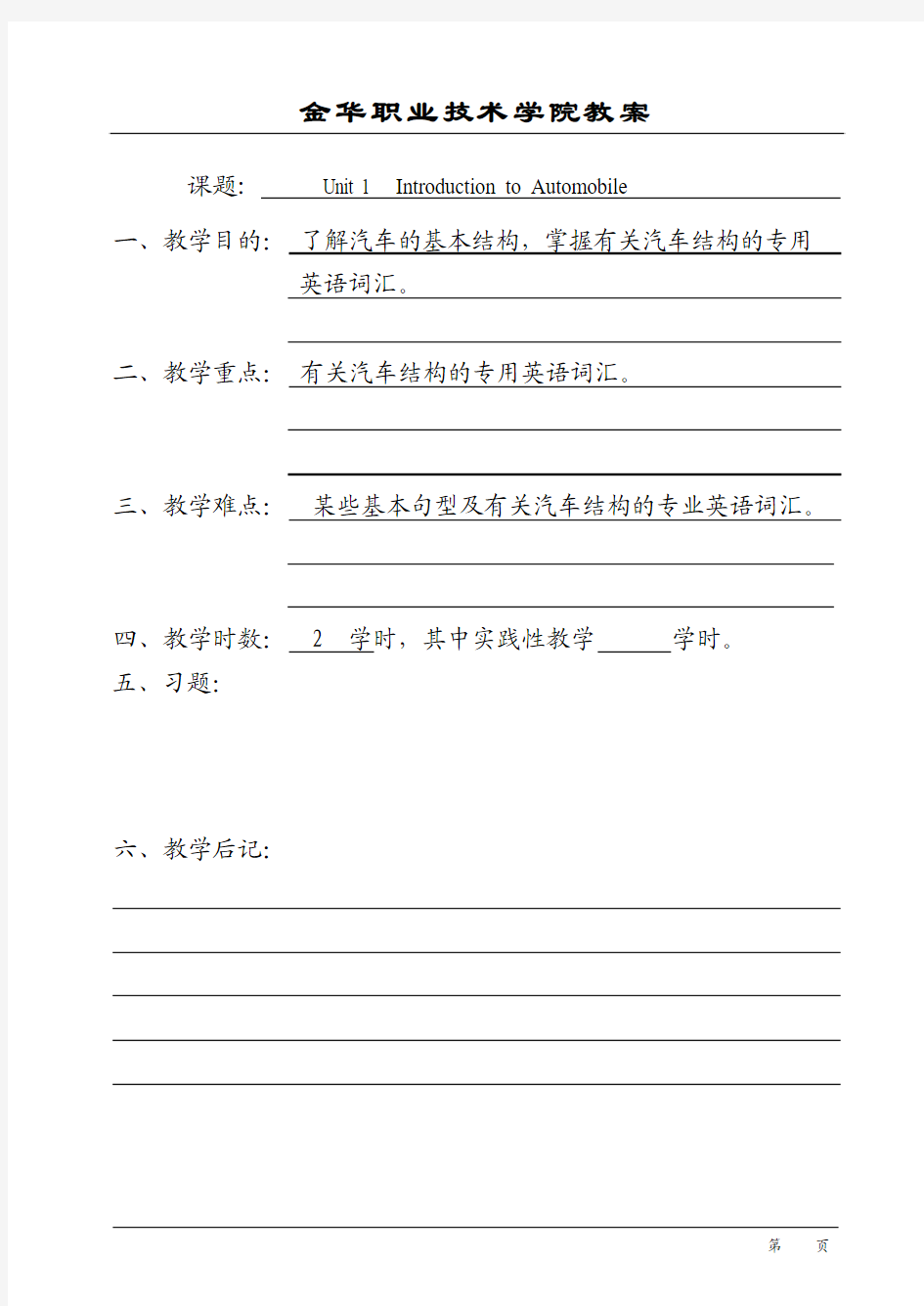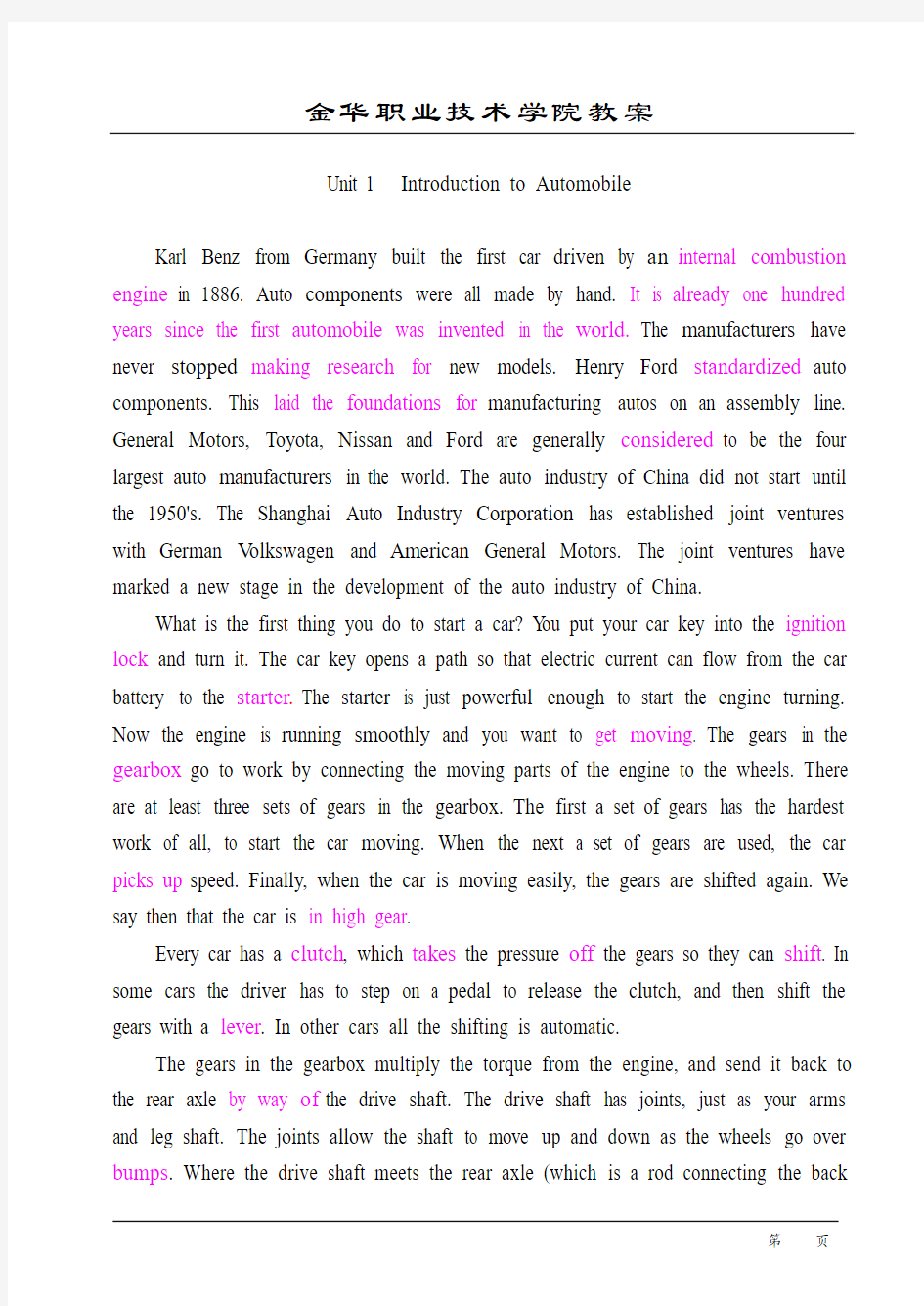Unit 1 Introduction to Automobile


课题: Unit 1 Introduction to Automobile
一、教学目的:了解汽车的基本结构,掌握有关汽车结构的专用
英语词汇。
二、教学重点:有关汽车结构的专用英语词汇。
三、教学难点:某些基本句型及有关汽车结构的专业英语词汇。
四、教学时数: 2 学时,其中实践性教学学时。
五、习题:
六、教学后记:
Unit 1 Introduction to Automobile
Karl Benz from Germany built the first car driven by an internal combustion engine in 1886. Auto components were all made by hand. It is already one hundred years since the first automobile was invented in the world.The manufacturers have never stopped making research for new models. Henry Ford standardized auto components. This laid the foundations for manufacturing autos on an assembly line. General Motors, Toyota, Nissan and Ford are generally considered to be the four largest auto manufacturers in the world. The auto industry of China did not start until the 1950's. The Shanghai Auto Industry Corporation has established joint ventures with German V olkswagen and American General Motors. The joint ventures have marked a new stage in the development of the auto industry of China.
What is the first thing you do to start a car? Y ou put your car key into the ignition lock and turn it. The car key opens a path so that electric current can flow from the car battery to the starter.The starter is just powerful enough to start the engine turning. Now the engine is running smoothly and you want to get moving. The gears in the gearbox go to work by connecting the moving parts of the engine to the wheels. There are at least three sets of gears in the gearbox. The first a set of gears has the hardest work of all, to start the car moving. When the next a set of gears are used, the car picks up speed. Finally, when the car is moving easily, the gears are shifted again. We say then that the car is in high gear.
Every car has a clutch, which takes the pressure off the gears so they can shift. In some cars the driver has to step on a pedal to release the clutch, and then shift the gears with a lever. In other cars all the shifting is automatic.
The gears in the gearbox multiply the torque from the engine, and send it back to the rear axle by way of the drive shaft. The drive shaft has joints, just as your arms and leg shaft. The joints allow the shaft to move up and down as the wheels go over bumps. Where the drive shaft meets the rear axle (which is a rod connecting the back
wheels), there is the group of gears called the differential. These gears turn the rear wheels. They let each wheel turn at its own speed when it is necessary. If the car is turning a corner, the outside wheel has to turn faster than the inside one, which acts as a sort of pivot.
Other gears connect the steering wheel to the front wheels which steer the car while the rear wheels push. The foot brake pedal and the hand brake are connected to the wheels too. When you press on the foot brake, friction bands push hard against the wheel drums and stop the wheels from turning. The hand brake is connected to the brake shoes on the rear wheels.
On the instrument panels there are several instruments which tell us what's going on under the hood. The gas gauge tells how much gasoline is in the tank. The oil gauge tells if the engine is getting enough oil (A thin film of oil has to keep flowing around all the moving parts of the engine to keep them working smoothly and safely). The ammeter tells if the generator is sending new electricity into the battery. This should be happening most of the time when the engine is running. The temperature gauge tells if the engine is being cooled enough. If there is not enough water in the radiator, or if the fan isn't blowing enough air back across the pipes, the engine gets too hot. The speedometer tells how fast the car is moving. It does this by measuring how fast the wheels are turning.
New words and phrase:
1、internal combustion engine [简明英汉词典] 内燃机
2、component [简明英汉词典] n. 元件,构件
3、be made by hand 手工制作
4、It is already one hundred years since the first automobile was invented in the world. (注意主、从句时态)
5、manufacturer [简明英汉词典] n.制造业者, 厂商
manual [简明英汉词典] n.手册, 指南
adj.手的, 手动的, 手工的, 体力的, 手册的
6、making research for 研究
7、stop +doing sth
stop +-to do sth 辨别:“停下一直在做的事”,“停下去做某事”
They stopped eating.
We stopped to rest. 我们停下来休息
8、standardize [简明英汉词典] vt.使符合标准, 使标准化
9、lay the foundations for 为……奠定基础
10、assembly line [简明英汉词典] n.(工厂产品的)装配线
11、General Motors, Toyota, Nissan and Ford are generally considered to be the four largest auto manufacturers in the world. 注意最高级使用。
12、joint venture 合资[合营]企业; 短期合伙[合资经营]
Proprietorship 独资企业
“foreign capital ”or “overseas investment”外资
13、ignition lock 点火开关
14、gearbox [简明英汉词典] n.变速箱(transmission)
AT: automatic transmission
MT: manual transmission
15、pick up speed [简明英汉词典] 加快速度
16、shift 换挡
17、clutch [简明英汉词典] n.离合器
18、multiply [简明英汉词典] v.乘, 增加
19、by way of [简明英汉词典] adv.经由, 作为, 为了
20、joint n.等速万向节,万向节,联轴节
21、bump [简明英汉词典] n.撞击,颠簸
22、differential n.差速器
23、pivot n.枢轴
24、steering wheel [简明英汉词典] 方向盘
25、front wheel [简明英汉词典] 前轮
26、foot brake pedal 脚制动踏板
Hand brake 手制动
27、friction band [简明英汉词典] 摩擦[带状]闸瓦
28、wheel drums 轮毂
29、brake shoe n.制动蹄
30、instrument panel [简明英汉词典] n.仪表板
31、hood [简明英汉词典] n.引擎罩
32、gas gauge 汽油量表
33、thin film of oil 薄薄的机油膜
34、ammeter n.安培计,电流表
35、radiator [简明英汉词典] n.散热器, 水箱, 冷却器,
36、speedometer [简明英汉词典] n.速度计, 里程计
作业:
1. translate the following expession into Chinese:
1) automobile
2) differential
3) chassis
4) electrical system
5) assembly
6) transmitting engine power to the driving wheels
7) steering system
8) wheel suspension
9) foot brake pedal
10) internal combustion engine
2. translate the following expressions into English:
1) 手工制作be made by hand
2)仪表板the instrument panels
3)制动蹄brake shoes
4)手制动hand brake
5)上海汽车工业公司Shanghai Auto Industry Corporation 6)电流表、安培表ammeter
7)汽油量表gas gauge
8)机油膜film of oil (oil film)
